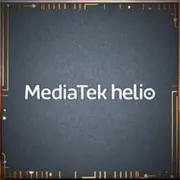MediaTek Helio G90T

MediaTek Helio G90T: A Powerful Mid-Range Player in 2025
Overview of Architecture, Performance, and Use Cases
Introduction
The MediaTek Helio G90T, introduced back in 2019, remains a popular choice for smartphones in the $200–$300 price segment. Despite its age, this system-on-chip (SoC) remains relevant thanks to software optimization and balanced specifications. In 2025, devices powered by the G90T are affordable solutions for gaming, multimedia, and everyday tasks. Let's explore what makes this processor noteworthy and who it is suited for.
1. Architecture and Process Technology: 12 nm and Hybrid Core Structure
CPU: 8 Cores with Cluster Division
The Helio G90T is built on a hybrid Big.LITTLE architecture:
- 2 Cortex-A76 cores with a frequency of up to 2.05 GHz for heavy tasks (gaming, rendering).
- 6 Cortex-A55 cores with a frequency of up to 2.0 GHz for background processes and energy efficiency.
This configuration allows for load distribution, saving battery life. However, the 12 nm process technology (TSMC) in 2025 appears outdated compared to 6 nm or 5 nm chips, affecting power consumption and heat generation, especially during prolonged gaming sessions.
GPU: Mali-G76 MP4
The Mali-G76 MP4 graphics processor with 4 cores supports HDR10 and resolutions up to 2520×1080 pixels. Its performance (~30% higher than the Mali-G72 used in the Helio G90) enables mobile games to run at medium settings:
- PUBG Mobile — stable 40–50 FPS in HD quality.
- Genshin Impact — 25–30 FPS at low settings (active cooling required).
For smooth operation in 2025, only optimized games like COD Mobile or Brawl Stars remain relevant.
2. Performance in Real-World Tasks
Gaming: Compromise Between Quality and Heat
Smartphones powered by the G90T, such as the Xiaomi Redmi Note 8 Pro (which can be found for $180–$220 in 2025), demonstrate:
- Stability in light and medium games (Asphalt 9, Mobile Legends).
- The need to lower graphic settings in AAA titles (Honkai: Star Rail).
- Heating up to 42–45°C after 30 minutes of gaming, necessitating the use of heat sinks or gel cases.
Multimedia and AI
- Support for 64 MP cameras and photo processing through AI algorithms (noise reduction, scene recognition).
- Video recording at 4K@30 fps or 1080p@60 fps, but without flagship-level EIS stabilization.
- Power consumption while watching YouTube is around 8–10% battery per hour (with a capacity of 4500 mAh).
Power and Thermal Management
The processor's TDP is 5 W, but under peak loads, consumption can reach 7–8 W. To compensate, smartphone manufacturers utilize:
- Copper heat pipes.
- "Smart" throttling modes (automatic frequency reduction when overheating).
3. Integrated Modules: Connectivity and Wireless Technologies
Modem and Networks
- 4G LTE Cat-12 with download speeds up to 600 Mbps.
- The lack of 5G is a major drawback in 2025, where even budget chips (Snapdragon 4 Gen 3) support sub-gigabit networks.
Wi-Fi and Bluetooth
- Wi-Fi 5 (802.11ac) with dual-band connectivity (2.4 GHz + 5 GHz).
- Bluetooth 5.0 with support for aptX HD codecs for wireless headphones.
Navigation
- GPS, GLONASS, Galileo — standard set for accurate positioning.
- No support for satellite communication (e.g., Emergency SOS via satellite).
4. Comparison with Competitors
2019–2020 Generation
- Snapdragon 730G: Better graphics (Adreno 618) and 8 nm process technology. In Antutu 10 tests, it scores around ~280K, but offers better FPS stability.
- Exynos 9611: Weaker in gaming (Mali-G72 MP3), but more efficient in video recording.
Modern Analogues (2025)
- Snapdragon 4 Gen 3: 6 nm, 5G, Antutu 10 — 400K. Devices start from $250.
- MediaTek Dimensity 6100+: 6 nm, 5G, Antutu 10 — 420K. Prices start from $230.
Conclusion: The G90T lags behind new chips in energy efficiency and 5G support, but it has the advantage of lower smartphone costs.
5. Use Cases
Gaming
Ideal for casual gamers who do not seek ultra settings. Models with active cooling, such as the Poco M3 Pro (priced at $210 in 2025), are recommended.
Everyday Tasks
- Smooth operation with social media, messaging, and streaming.
- Multitasking: running 5–7 applications simultaneously.
Photo and Video
- Cameras up to 64 MP with AI-enhanced detail.
- Night shooting requires static scenes — dynamic objects become blurred.
6. Pros and Cons
Strengths:
- Affordable device prices.
- Good graphics for less demanding games.
- Support for high-resolution cameras.
Weaknesses:
- Lack of 5G.
- Heating under load.
- Limited performance in resource-intensive applications.
7. Tips for Choosing a Smartphone with Helio G90T
1. Cooling. Look for models with liquid cooling or large heat sinks.
2. Battery. Ideally, a 5000 mAh battery to compensate for power consumption.
3. Display. An AMOLED panel with a 90 Hz refresh rate will enhance the experience (e.g., Realme 7).
4. Price. Don’t pay more than $250 — there are already devices in this segment with 5G support.
8. Final Conclusion: Who Is the Helio G90T For?
This processor is a choice for those who:
- Are not ready for 5G. If you live in an area with slow rollout of new networks.
- Value balance between price and performance. For $200–250, you can get a smartphone with a good screen, camera, and enough battery life.
- Games occasionally. Casual gamers will find enough power, but hardcore gamers may want to consider the Dimensity 8000 series.
Key Benefits: Budget savings without serious compromises on basic scenarios. In 2025, the Helio G90T remains a niche but viable option amid global digital transformation.
Basic
6x 2 GHz – Cortex-A55
GPU Specifications
Connectivity
Memory Specifications
Miscellaneous
Benchmarks
Compared to Other SoC
Share in social media
Or Link To Us
<a href="https://cputronic.com/en/soc/mediatek-helio-g90t" target="_blank">MediaTek Helio G90T</a>